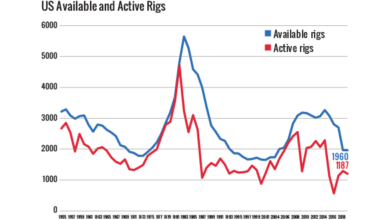Gulf of Mexico lease sale proposed for August
Officials with the US Department of Interior announced in early March a proposed offer of 78 million acres for a regionwide lease sale scheduled for August 2019. The sale would include all available unleased areas in federal waters of the Gulf of Mexico. Lease sale 253 will be the fifth offshore sale under the 2017-2022 National Outer Continental Shelf (OCS) Oil and Gas Leasing Program. It will include approximately 14,699 unleased blocks, located from 3 to 231 miles offshore, in the Gulf’s Western, Central and Eastern planning areas in water depths ranging from 9 to more than 11,115 ft.
The Gulf of Mexico OCS, covering more than 164 million acres, is estimated to contain more than 47 billion bbl of undiscovered technically recoverable oil and 141 trillion cu ft of undiscovered technically recoverable gas.
IOGP consolidates resources on managing fatigue in the workplace
The International Association of Oil and Gas Producers (IOGP) recently announced the publication of the IOGP-IPIECA Report 626 – Managing Fatigue in the Workplace.
This publication brings together and updates all elements of the four previous publications on the topic: Report 392 – Fatigue Management in the Workplace; Report 488 – Performance Indicators for Fatigue Risk Management Systems; Report 492 – Assessing Risks from Operator Fatigue; and Report 536 – Fatigue Fly-in, Fly-Out Operations. The new report is now one resource to help organizations implement, monitor and manage fatigue risk management systems.
The report comes with three supplementary documents and file packages that expand upon and provide implementation tools for the main report.
US Department of Labor Proposes rule to update fair labor standards act
In late March, the US Department of Labor announced a proposed rule to amend and update its regular rate requirement under the Fair Labor Standards Act (FLSA). The FLSA generally requires overtime pay of at least one and a half times that of the regular rate of pay for hours worked in excess of a 40-hour workweek. Regular rate requirements define what forms of payment employers include and exclude in the “time and one-half” calculation when determining workers’ overtime rates.
The proposed rule focuses on clarifying whether certain kinds of perks, benefits or other miscellaneous items must be included in the regular rate. Because these regulations have not been updated in decades, the proposal would better define the regular rate for today’s workplace practices and would include clarification on several items.
Colorado Governor signs ‘protect public welfare oil, gas operations’ bill
On 16 April, Colorado Gov. Jared Polis signed Bill 181, Protect Public Welfare Oil and Gas Operations, into law. The sweeping oil and gas bill, which is expected to represent a major shift in regulatory authority over drilling in Colorado, was passed by the Colorado Senate on 3 April.
The bill concerns additional public welfare protections regarding the conduct of oil and gas operations. It prioritizes the protection of public safety, health, welfare and the environment in the regulation of the oil and gas industry by modifying the oil and gas statute and by clarifying, reinforcing and establishing local governments’ regulatory authority over the surface impacts of oil and gas development. This means that local governments will have significantly more power to decide where drilling can happen.
US federal judge in Alaska blocks arctic drilling
On 31 March, a federal judge in Alaska ruled that the Executive Order issued by US President Donald Trump in April 2017 that would have opened previously closed waters in the Arctic and Atlantic Coast to oil and gas drilling is unlawful.
President Barack Obama put restrictions in place in 2015 and 2016 that banned Arctic drilling in roughly 125 million acres of the Arctic coastal shelf in Alaska. The new ruling affirms that President Trump’s Executive Order overstepped his authority and that, under Section 12(a) of the Outer Continental Shelf Lands Act, only Congress has the authority to reverse prior withdrawals. The ruling does not affect existing oil and gas leases in the Beaufort Sea. The ruling is expected to be appealed to the Ninth Circuit Court of Appeals.
BLM changes protections for Sage-Grouse Bird
On 15 March, the US Depart of the Interior’s Bureau of Land Management (BLM) issued Records of Decision amending land use plans for greater sage-grouse habitat management on public lands, providing special protection measures for nearly 60 million acres. The decisions received bipartisan support from the governors who sought revisions to the plans that guide conservation of sagebrush steppe habitat on BLM-administered public lands in their respective states. The goal was to better align BLM plans for managing habitat with state plans for conserving the species.
The decisions affect resource management plans for BLM-administered public lands in seven western states. The plans build on those put into place in 2015. In 2017, the BLM began scoping for the new plans, asking whether “some, none or all” of the 2015 sage-grouse plans should be amended. The planning effort that concludes with the March decision began in 2017, when governors of most of the affected sage-grouse states asked the BLM to revisit existing plans for managing sage-grouse habitat and adapt them to better meet the needs of individual states.
In response, the BLM proposed changes developed in collaboration with governors and state wildlife agency professionals in the seven affected states, as well as other concerned organizations and individuals, largely through the Western Governors Association’s Sage-Grouse Task Force.
IADC supports alternative compliance policy
In March, the US Bureau of Safety and Environmental Enforcement (BSEE) responded to members of the House Committee on Natural Resources regarding the committee’s inquiry into the bureau’s alternative compliance practice. IADC supports BSEE’s position that drilling for vast offshore natural resources in the US requires regulations that recognize the fact that a one-size-fits-all approach is not feasible. Therefore, availing alternative equivalents for sustaining offshore safety and the environment is an imperative.
IADC President Jason McFarland noted: “Since the late 1980s, BSEE has allowed the use of alternative procedures and equipment as long as they meet or exceed the level of safety and environmental protection required by current regulation. In administration of this process, BSEE has and continues to demonstrate the most appropriate application of technology and best practice. Such an approach is essential for effective management of highly variable offshore characteristics associated with geology, well depth and water depth, making each well exceedingly unique.
“Contrary to recent public reports, applying for and obtaining an alternative compliance authorization is not tantamount to a ‘waiver.’ Companies must demonstrate, in detail, how their proposed alternative meets the stringent requirements for safety and protection of the offshore environment. IADC continues to advocate for regulation that is transparent and is implementable. It is from this most reasonable perspective that we strongly support BSEE’s proven methods for exercising a prudent alternative compliance process.”
$200.5 million proposed for 2020 BSEE budget
US President Donald Trump has proposed a $200.5 million Fiscal Year 2020 budget for the Bureau of Safety and Environmental Enforcement (BSEE). The proposed budget will fully support BSEE’s efforts to foster safe and environmentally sustainable energy development of the United State’s offshore energy resources on the Outer Continental Shelf. The 2019-2022 Strategic Plan will build on Fiscal Year 2019’s efforts and will continue to guide the bureau in strengthening environmental safeguards.
The budget will support several priorities, including safe and environmentally sustainable energy development; enhancing mission capacity and accountability; and oil spill preparedness and research.
173 of 206 parcels auctioned off in Wyoming lease sale
The Wyoming Office of State Lands and Investments held the first oil and gas lease auction for 2019 on 19 March. It resulted in 173 of the 206 offered parcels receiving successful bids to lease 54,096 acres. The auction grossed $4,535,748.08 for the benefit of the state’s trust beneficiaries.




